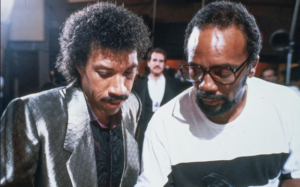THE GREATEST NIGHT IN POP: 3 ½ STARS. “Check your ego at the door.”
 If a bomb dropped on A&M Recording Studios in Hollywood on January 28, 1985, the Billboard charts may never have recovered. Save for superstars Prince and Madonna, the entirety of American pop royalty, 46 performers in total, gathered to check their egos at the door, and record “We Are the World,” the American answer to Bob Geldof’s supergroup charity single “Do They Know it’s Christmas?”
If a bomb dropped on A&M Recording Studios in Hollywood on January 28, 1985, the Billboard charts may never have recovered. Save for superstars Prince and Madonna, the entirety of American pop royalty, 46 performers in total, gathered to check their egos at the door, and record “We Are the World,” the American answer to Bob Geldof’s supergroup charity single “Do They Know it’s Christmas?”
The song became the fastest-selling U.S. pop single in history, selling 20 million copies, and raising tens-of-millions for humanitarian aid under the umbrella of United Support of Artists for Africa (USA for Africa). A new documentary called “The Greatest Night in Pop,” now streaming on Netflix, takes us behind the scenes of the historic recording session.
In the opening third of the film, director Bao Nguyen sets the stage, “Behind the Music” style, using archival footage and new talking head interviews with the major players, to teleport the viewer back to the heady days of the original Macintosh personal computer and when “Purple Rain” made Prince the first artist to score a number one song, album and movie at the same time in North America.
Music icon and activist Harry Belafonte noted the success of Band Aid’s “Do They Know It’s Christmas?” to raise awareness and funds to fight famine in Africa, and put into motion the idea that would become “We Are the World.” In short order, fundraiser and music agent Ken Kragen came on board, raided his Rolodex, and brought together Lionel Ritchie, Michael Jackson and producer Quincy Jones to create a song to be sung by an all-star choir.
From the writing of the tune and the machinations involved in recruiting the a-list talent, made somewhat easier by scheduling the session after the American Music Awards ceremony when virtually the entire music industry was in Los Angeles for the event, to the placement of the microphones and Jones’s famous “Check your ego at the door” sign, Nguyen breezes through the events leading up to the actual recording.
It is a straightforward setting of the scene, that leads into the remarkable footage taken on the night, as some of the most famous people in the world came together to learn and record a song while also shooting the music video that would accompany the release.
It’s here the documentary becomes something more than an episode of “I Love the ‘80s.” The footage unveils the effort, the raw talent and spirit of camaraderie among the legends, who almost immediately becomes starstruck fans, asking their idols for autographs in between takes and expressing shyness about singing in front of music legends like Ray Charles and Bob Dylan.
There are funny moments—Cyndi Lauper’s many necklaces are identified as the strange sound ruining take after take—some unexpected ones—Bob Dylan’s vocal insecurity, for instance—and touching scenes of the artists overcome by emotion, including Diana Ross who cried when it was all done. “I don’t want this to be over,” she said as equipment is packed up around her.
At the helm is Jones. To manage the talent, the egos and insecurity of a roomful of superstars, Huey Lewis notes, “You gotta be more than a great musician, you have to be a psychiatrist,” and it is remarkable to watch Jones mollycoddle, push and prod this group. He knows what he wants and always seems to know how to get it. It’s a remarkable peak into the work of a virtuoso.
“The Greatest Night in Pop” is an exercise in nostalgia and certainly doesn’t reinvent the music documentary form, but the work of the collected musicians on that one special night remains as inspiring today as it was thirty-nine years ago.
